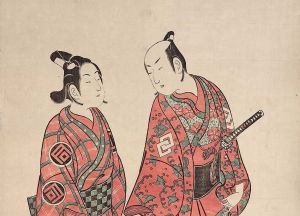Pederasty in Japanese culture
- BoyWiki presents a historical list of pederastic relationships in Japan. Our article summarizes the cultural phenomenon as it stands today.
Japan has a long rich history of Wakashudou (boylove), homosexuality, and bisexuality that was influenced by the history of Shinto and Buddist cultural traditions. In the modern era Japan has several genres of art that feature the sexual exploration of characters with youthful and/or child-like features including Shota, lolicon, bishōnen, boys love, and shounen'ai.

Buddhism
Japan's tradition Buddhist tradition includes the practice of nanshouku where "an older Buddhist monk called the nenja would take on a prepubescent boy, called the chigo, as his acolyte." Later, the samurai brought this tradition out of the monasteries and into the public where it was known as Wakashudou. In wakashudō, prepubescent boys would be apprenticed to an older man. He would learn martial arts, life skills, and, if the boy agreed, be the man's lover until he became an adult.
Recently Japan has wrestled with it's relationship to minor attraction, torn between it's own traditions and modern western efforts to criminalize minor attraction. Until 2023, Japan had "the lowest Age of Consent[1][2] in developed countries, and the lowest in the G7 group." A move to raise the age of consent to 16 recently aligned it more closely with modern western laws.
Shinto influences; A traditional perspective on sexuality
Japan's oldest major religion, Shinto puts sex before creation[3] when 2 Kami decide to have sex then which forms Japan:
At this time Izanagi-no-Mikoto asked his spouse Izanami-no-Mikoto, saying: "How is your body formed?"
She replied, saying: "My body, formed though it be formed, has one place which is formed insufficiently."
Then Izanagi-no-Mikoto said: "My body, formed though it be formed, has one place which is formed to excess. Therefore, I would like to take that place in my body which is formed to excess and insert it into that place in your body which is formed insufficiently, and thus give birth to the land. How would this be?"
Izanami-no-Mikoto replied, saying: "That will be good."
In Shinto belief all "all sexual love is unconditional good,"[3] sharply contrasting the Judeo-Christian association of sex with impurity and punishment. Japan's largest religion is fundamentally sex-positive which affects all aspects of Japanese relationship to sexuality.
Apprenticeships

Wakashu was a term from the Edo period referring to a Japanese young person who was a male beyond early childhood, but wasn't considered a man. Wakashu aged 7 to 17 wore their hair partially shaven. The boys could begin formal education, become an apprentice, or find a job.
In the 12th century sons of the ruling class Samurai would be sent to Buddhist monasteries for education. As acolytes, the sons were introduced to the nanshuko tradition by older monks. The samurai expanded nanshuoku out of the monasteries and into the cities.
Wakashudo
The samurai version was called wakashudō. Boys would be apprenticed to an older man who taught them life skills, martial arts, and social skills. The pair would formalize a "brotherhood contract"
The idea was that this wakashudō relationship should have a 'mutually ennobling effect' on the pair. They were expected to 'assist each other in feudal duties in honor-driven obligations such as duels and vendettas. Although sex between the couple was expected to end when the boy came of age, the relationship would, ideally, develop into a lifelong bond of friendship. At the same time, sexual activity with women was not barred (for either party), and once the boy came of age, both were free to seek other wakashū lovers.
Gregory Pflugfelder[3]
The tradition and it's reception as a cultural institution echoes Greek Love in that it was considered a high-class behavior which eventually expanded to the merchant class who took on servant boys and apprentices.
Artistic genres featuring child romance
Shota features romantic drawings of pubescent and putrescent boys. Lolicon is similar art involving girls. This includes manga, anime, and other media representations.
The term "shotacon" is a Japanese contraction of Shōtarō complex (正太郎コンプレックス, _Shōtarō konpurekkusu_), a reference to the young male character Shōtarō (正太郎) from Tetsujin 28-go[4] who is considered a beautiful young boy or bishōnen.
Gallery
-
Soccer player boy drawn in anime or shota style
-
A beautiful boy drawn in anime style wearing a suit and holding his face in his hands
Modern age of consent policy changes
Japan's age of consent was 13 years old as recently as 2023. A Japanese Justice Ministry panel proposed (successfully) an age of 16.[2] Teen couples will be exempt from prosecution if both partners are over 13 and no more than five years apart in age. Hiranao Honda objected to raising Japan’s age of consent from 13 to 16 arguing that "12- and 20-year-olds can have serious relationships,” and "Japan’s age of consent is not that low compared to other nations."[5]
See also
References
- ↑ Japanese Politician Regrets Saying It’s OK to Have Sex with 14-Year-Old (Vice)
- ↑ 2.0 2.1 Japan aims to raise age of consent from 13 to 16 in sex crime overhaul (BBC)
- ↑ 3.0 3.1 3.2 Tofugu: The Gay of the Samurai. All About Homosexuality, Buddhist Monks, Samurai, and The Tokugawa Middle Class
- ↑ Saitō Tamaki (2007) "Otaku Sexuality" in Christopher Bolton, Istvan Csicsery-Ronay Jr., and Takayuki Tatsumi ed., page 236 Robot Ghosts and Wired Dreams. Archived. University of Minnesota Press, ISBN 978-0-8166-4974-7. "Shota is an abbreviation for “Shotaro complex,” from Kaneda Shotaro, the boy who pilots the robot in the manga and anime Tetsujin 28 go (what became Gigantor in English). Originally an offshoot of yaoi, the origins of this genre are said to begin in the early 1980s."
- ↑ Japan raises age of consent from 13 to 16 years old

